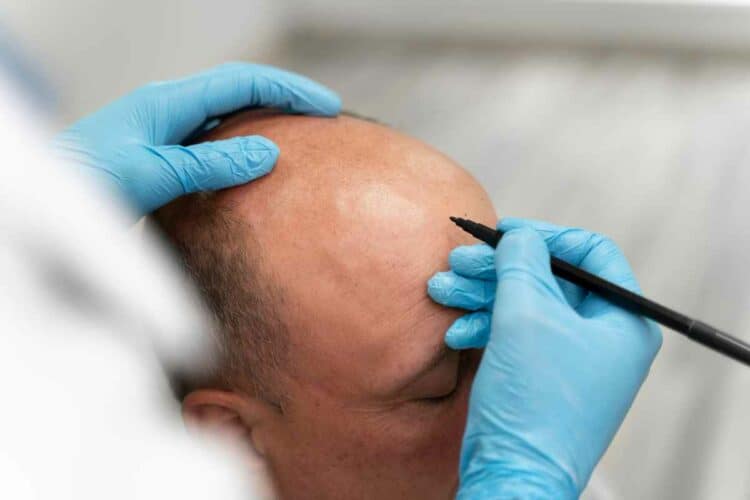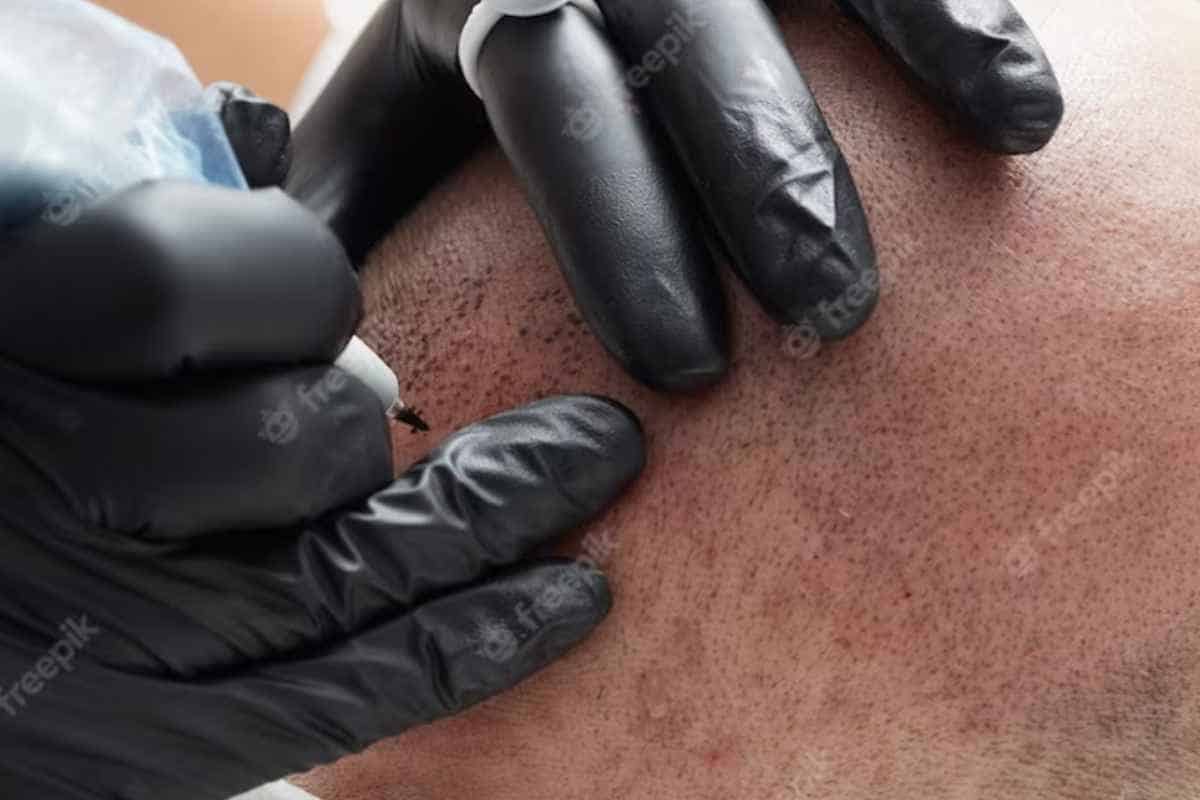Are you tired of feeling self-conscious about your hairline? Have you considered scalp micropigmentation a solution but worry that scalp micropigmentation looks fake? You’re not alone. Many people are hesitant to try scalp micropigmentation because they’ve seen examples of unnatural procedures.
But here’s the good news: scalp micropigmentation doesn’t have to look fake. In fact, when done correctly, it can provide a natural and realistic appearance.
We’ll explore the problem of scalp micropigmentation looking fake, agitate those concerns, and provide a solution for a natural-looking result. Say goodbye to the helmet effect and hello to a confident new you.
Benefits of scalp micropigmentation

Scalp micropigmentation (SMP) is a non-invasive and natural hair restoration procedure with several benefits. It uses a micro-needling process to duplicate microscopic hair follicles, making it ideal for men and women suffering from hair loss or thinning.
SMP is a great solution for those who prefer a trimmed or near-shaven look and can work for people with overall diffuse hair thinning. Unlike other hair restoration methods, SMP offers a natural-looking result that can boost one’s confidence.
It is also a cost-effective option that requires no downtime or recovery period. Overall, SMP is a great option for people looking for a non-surgical hair restoration solution that looks and feels natural.
Does scalp micropigmentation look real or fake?
Scalp micropigmentation (SMP) is a form of cosmetic tattooing that implants natural pigments under the top layer of the skin using a microneedle. SMP aims to recreate the natural look of dense hair and a well-defined hairline for men experiencing hair loss.
The technique involves implanting pigment in a series of tiny dots resembling natural hair follicles, creating the illusion of density or thicker hair. The pigment matches the client’s hair color and skin tone, and the size and shape of the dots are determined to create a natural-looking hairline.
SMP can last for several years before touch-ups are needed to maintain the appearance of real hair. When done correctly, SMP looks very realistic and does not appear fake. It can boost confidence in those experiencing hair loss and provide a subtle, natural-looking hairline.
How does scalp micropigmentation work?

Scalp micropigmentation is a cosmetic procedure that involves the application of small dots of pigment to the scalp, creating the illusion of a full head of hair. The procedure is performed using a specialized tattoo machine designed to deposit the pigment into the skin in a precise and controlled manner. The technician will use a variety of needle sizes and configurations to create the look of natural hair follicles, taking care to match the color and texture of the client’s existing hair as closely as possible.
To create a natural-looking hairline, the technician will work with the client to determine the best placement and shape for the hairline. This may involve using a stencil or template to guide the placement of the pigment, or it may be done freehand. The goal is to create a hairline that is not too low or too high and follows the natural contours of the client’s face.
Factors that contribute to a realistic-looking result include the skill and experience of the technician, the quality of the pigment used, and the aftercare regimen followed by the client. Choosing a reputable clinic with trained and experienced technicians and carefully following all aftercare instructions is important to ensure the best possible outcome.
With proper technique and care, scalp micropigmentation can create a natural-looking hairline virtually indistinguishable from the real thing.
What are the different types of pigments used for scalp micropigmentation?
Scalp micropigmentation technicians use two types of pigments: organic and inorganic. Organic pigments are derived from natural materials and considered more biocompatible, making them less likely to cause an allergic reaction. However, organic pigments tend to fade faster than inorganic pigments and may require more touch-up sessions.
Inorganic pigments, on the other hand, are synthetic and tend to last longer than organic pigments. They also tend to retain their color better and require fewer touch-up sessions. However, inorganic pigments may be more likely to cause an allergic reaction, and some experts caution that they may not be as biocompatible as organic pigments.
Ultimately, the choice of pigment will depend on the client’s individual needs and preferences and the technician’s experience and expertise.
Over to You
Scalp micropigmentation is a safe and effective way to improve the appearance of your hair. If you are considering this procedure, be sure to consult with a qualified doctor to ensure that it is right for you.
FAQs
Does SMP look real up close?
Yes, scalp micropigmentation (SMP) can look real up close if done correctly by a skilled and experienced artist. The results of SMP can vary based on the artist’s style, method, and expertise. Choosing an artist who can recreate your natural hairline and tailor the style, density, and placement to suit your age, stage, style, and face shape is important.
Can you tell if someone has scalp micropigmentation?
Scalp micropigmentation can look completely realistic if done properly by a qualified and experienced artist. SMP aims to get a natural-looking result, and most people wish to undergo treatment without it being detected. However, it is essential to thoroughly research the facility and SMP technician who will be doing your treatment.
How does SMP help conceal hair loss in the hairline?
Scalp micropigmentation (SMP) is a hair restoration procedure that works by administering pigments underneath the outer layer of skin, creating imitation hair follicles that conceal the problem of hair loss.
The procedure doesn’t guarantee new hair growth, but it offers a natural-looking result indistinguishable from a full head of hair. The degree of hair loss suffered matters, but the best scalp technician knows how to work on a scalp with thinning hair to restore the look of a full head of thick hair.
How to get a natural scalp micropigmentation finish?
To achieve a natural-looking scalp micropigmentation finish, it is essential to follow certain guidelines. The primary goal is to recreate the appearance of a well-defined hairline and dense hair.
Poorly administered treatment or incorrect decisions can result in an obvious and unnatural look. Therefore, finding a skilled and experienced practitioner is crucial to ensure a natural and elegant finish.
What determines whether a scalp micropigmentation treatment is done right or not?
The success of a scalp micropigmentation treatment depends on several factors. Blending, color matching, and the technician’s expertise are critical for achieving a natural and seamless look. Choosing a skilled practitioner, communicating effectively, following pre-treatment rules, and researching thoroughly can ensure a successful outcome.



